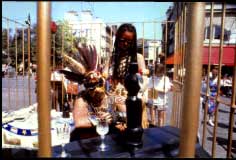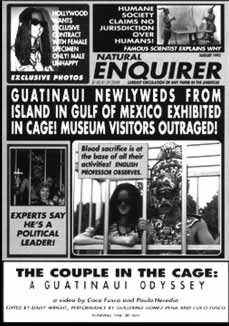A man and a woman, both artists, had an idea for a new piece of art. Its aim was to satirize the concept of discovery; a social experiment. They displayed themselves in a cage as Amerindians from a fictitious ('undiscovered') island in four different countries. They were making an allusion to colonial practices in the 16th- 20th centuries in which natives were brought to Western countries and shown to the public. They soon began to see that audiences actually believed they were real. Throughout their performances, people took photos with them and children even interacted with them as if they were a rare curiosity. They rarely spoke, but only on occasion to tell stories in a fake language. The native 'traditions' they did included: sewing voodoo dolls, watching the television and, the use a laptop. Audiences were awed at this 'King Kong'- like "discovery" and treated them like they were unintelligent savages or a circus act. They were highly misunderstood , but few people realized the 'joke'. Some people were really outraged that humans were being displayed in this manner and decided it may be a hoax. The artists' interactions with the people resembled cross- cultural misjudgments people make that are still relevant today.
This work raises the question of authenticity and how people still make stereotypes on things they do not understand of have knowledge about. For this work, museums agreed to let them perform. This shows the power museums hold as to what they want displayed. Fusco and Gomez- Pena make good points about people believing something that is not true and the common misconceptions that are bound to take place. They truly convinced many spectators using maps, make-up, native attire, false history and their odd actions. I believe that people should take the time to really determine the realness of something and not make ridiculous misconceptions. This also brings up a morality issue. Is it right to make people that are from a different culture seem exotic and rare like animals? They are human and should not be mistreated and made feel like they are objects for entertainment. People need to think about the credibility on things they see on a normal day. We need to question the 'real', the 'norms', and 'the unknown'. Fear and acceptance of facts deter us from inquiring. The problem is that people are not trained to ask something "different" or to be daring.
As for my opinion, I think this piece is informative and thought provoking. I personally would not have believed the exhibit because I have background knowledge on Native American culture. The most interesting thing I learned about was their breakthrough on medicinal practices. I specifically learned about the Shamans. They came before modern medicine and used natural plants to heal the sick. They were very amazing people with a long rich history!
So, if we are made to believe certain things how can we deviate ourselves from it? How do we know what to believe? Why do people tend to believe something that is stereotyped? How far does the authority of museums go in terms of the interpretation of art? To what extent do people misunderstand other races and cultures?





No comments:
Post a Comment